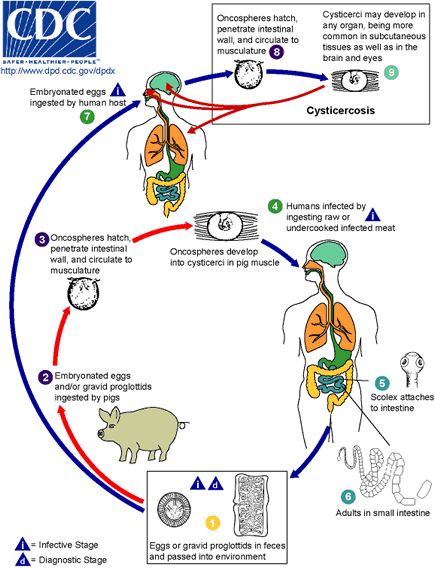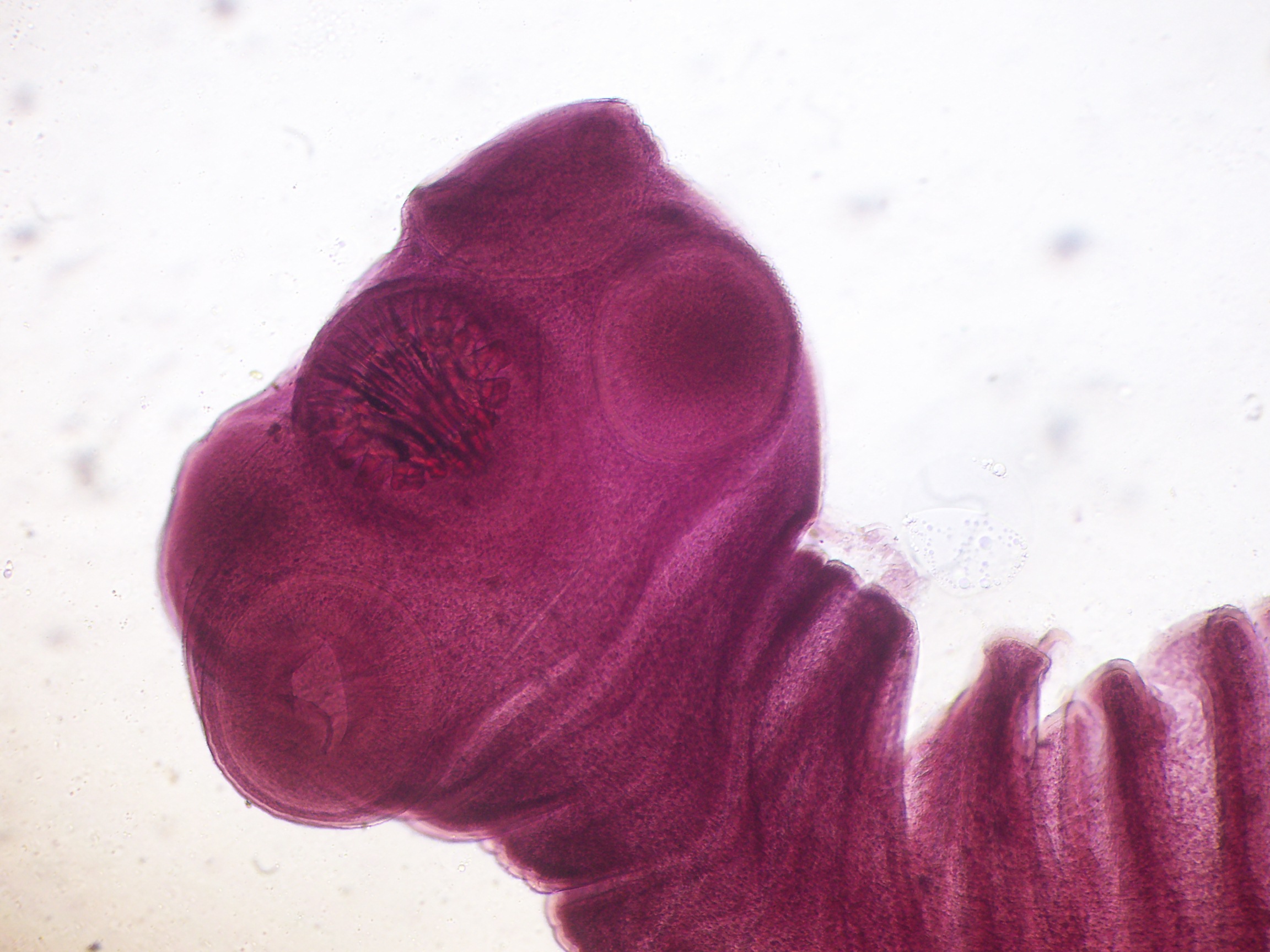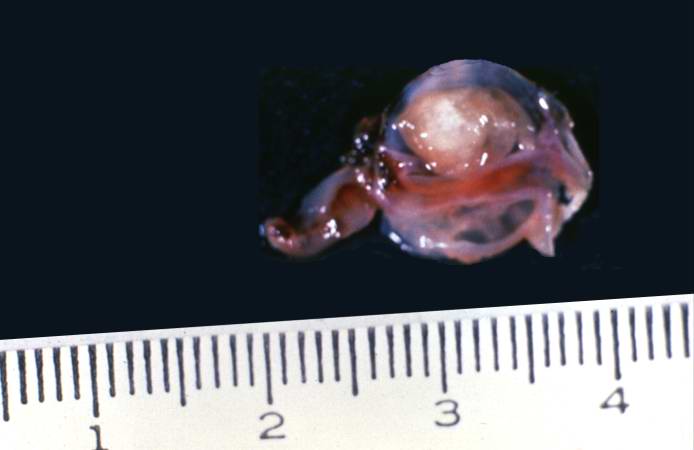Cysticercosis pathophysiology: Difference between revisions
Ahmed Younes (talk | contribs) No edit summary |
m (Bot: Removing from Primary care) |
||
| (17 intermediate revisions by 5 users not shown) | |||
| Line 7: | Line 7: | ||
== Pathophysiology== | == Pathophysiology== | ||
[[Image:Cysticercosis LifeCycle.gif|left|thumb|400px|Life cycle of T. solium with resulting cysticercosis]] | [[Image:Cysticercosis LifeCycle.gif|left|thumb|400px|thumb|Life cycle of T. solium with resulting cysticercosis - Source: https://www.cdc.gov/]] | ||
The [[cestode]] (tapeworm) Taenia solium (pork tapeworm) is the main cause of human cysticercosis. In addition, the larval stage of other Taenia species (e.g., multiceps, serialis, brauni, taeniaeformis, crassiceps) can infect humans in various sites of localization including the [[brain]], [[subcutaneous tissue]], [[eye]], or [[liver]]. | The [[cestode]] (tapeworm) Taenia solium (pork tapeworm) is the main cause of human cysticercosis. In addition, the larval stage of other Taenia species (e.g., multiceps, serialis, brauni, taeniaeformis, crassiceps) can infect humans in various sites of localization including the [[brain]], [[subcutaneous tissue]], [[eye]], or [[liver]]. | ||
===Pathogenesis & life cycle=== | ===Pathogenesis & life cycle=== | ||
*Cysticercosis is transmitted to the | *Cysticercosis is transmitted to the human host via ingesting embryonated [[Taenia solium]] eggs or gravid proglottids in contaminated foods or drinks<ref name="urlClinical manifestations and diagnosis of cysticercosis">{{cite web |url=https://www.uptodate.com/contents/clinical-manifestations-and-diagnosis-of-cysticercosis?source=search_result&search=cysticercosis&selectedTitle=1~25#H2 |title=Clinical manifestations and diagnosis of cysticercosis |format= |work= |accessdate=}}</ref> | ||
*Following [[ingestion]], oncospheres hatch from the eggs, penetrate the [[intestinal wall]] into the [[circulation]] then penetrate the tissues of several organs [[neural]] ([[Parenchyma|parenchymal]] and extraparenchymal) or extraneural ([[striated muscle]], [[liver]] , etc | *Following [[ingestion]], oncospheres hatch from the eggs, penetrate the [[intestinal wall]] into the [[circulation]] then penetrate the tissues of several organs [[neural]] ([[Parenchyma|parenchymal]] and extraparenchymal) or extraneural ([[striated muscle]], [[liver]], etc.)] to form cysticerci in them. | ||
*During early stages when the cysticerci are viable, they can evade the [[immune system]] so | *During early stages when the cysticerci are viable, they can evade the [[immune system]] so no [[inflammatory response]] is triggered by their presence & patient remains [[asymptomatic]]. Infection can remain asymptomatic for years. | ||
*But later in the disease, | *But later in the disease, cysts degenerate and cysticerci lose the ability to evade the [[immune system]] resulting in an [[inflammatory response]]. This inflammatory response is responsible for the presenting symptoms. | ||
In other words, the cysticerci themselves are not the cause of the symptoms but it is the [[inflammatory response]] that is triggered (usually late when they degenerate) | In other words, the cysticerci themselves are not the cause of the symptoms, but it is the [[inflammatory response]] that is triggered (usually late when they degenerate) | ||
===N.B.=== | ===N.B.=== | ||
*Pigs can get infected by eating [[human feces]] infected with the eggs but ingestion of undercooked [[pork]] containing larval cysts does not cause cysticercosis . It only causes [[taeniasis|intestinal tapeworm (taeniasis)]]<ref name="urlCDC - Cysticercosis">{{cite web |url=https://www.cdc.gov/parasites/cysticercosis/ |title=CDC - Cysticercosis |format= |work= |accessdate=}}</ref> | *Pigs can get infected by eating [[human feces]] infected with the eggs but ingestion of undercooked [[pork]] containing larval cysts does not cause cysticercosis. It only causes [[taeniasis|intestinal tapeworm (taeniasis).]]<ref name="urlCDC - Cysticercosis">{{cite web |url=https://www.cdc.gov/parasites/cysticercosis/ |title=CDC - Cysticercosis |format= |work= |accessdate=}}</ref> | ||
*[[Humans]] with cysticercosis only are dead end hosts | *[[Humans]] with cysticercosis only are dead end hosts, meaning that they are not able to transmit the infection while humans having [[teniasis|intestinal tapeworm disease (teniasis)]] are the source of infection. | ||
===Gross Pathology:=== | ===Gross Pathology:=== | ||
*[[Cysts]] | *[[Cysts]] round to oval | ||
*Contain lucent or semi tranclucent fluid | *Contain lucent or semi tranclucent fluid | ||
*Size usually | *Size usually ranges from 1-2 cm | ||
* | *Cyst numbers vary from patient to patient (can be hundreds) | ||
[[Image:Gross_1.jpg|500px|© Copyright UAB and the UAB Research Foundation, 1999-2013. All rights reserved | [[Image:Gross_1.jpg|500px|© Copyright UAB and the UAB Research Foundation, 1999-2013. All rights reserved | ||
]] | ]] | ||
| Line 37: | Line 36: | ||
===Microscopic Pathology:=== | ===Microscopic Pathology:=== | ||
There are 4 identified microscopic pictures which correlate with the stages of the disease<ref name="urlwww.archivesofpathology.org">{{cite web |url=http://www.archivesofpathology.org/doi/pdf/10.1043/2008-0756-RS.1?code=coap-site |title=www.archivesofpathology.org |format= |work= |accessdate=}}</ref> | There are 4 identified microscopic pictures which correlate with the stages of the disease.<ref name="urlwww.archivesofpathology.org">{{cite web |url=http://www.archivesofpathology.org/doi/pdf/10.1043/2008-0756-RS.1?code=coap-site |title=www.archivesofpathology.org |format= |work= |accessdate=}}</ref> | ||
{| style="float: right; width: 350px;" | {| style="float: right; width: 350px;" | ||
| [[Image:Taenia_solium_scolex.jpg|right|400px|By | | [[Image:Taenia_solium_scolex.jpg|right|400px|thumb|Taenia solium scolex - By https://es.wikipedia.org/wiki/User:Rjgalindo, class="extiw" title="es:User:Rjgalindo">Rjgalindo</a> from <a href="https://es.wikipedia.org/wiki/" class="extiw" title="es:">es</a>, <a href="http://creativecommons.org/licenses/by-sa/3.0/" title="Creative Commons Attribution-Share Alike 3.0">CC BY-SA 3.0</a>, <a href="https://commons.wikimedia.org/w/index.php?curid=2496706">Link</a>]] | ||
|} | |} | ||
====Vesicular stage==== | ====Vesicular stage==== | ||
*The cysticerci are viable | *The cysticerci are viable | ||
*Composed of a [[cavity]] containing a clear fluid and inside it lies the larvae | *Composed of a [[cavity]] containing a clear fluid and inside it lies the larvae | ||
*Each one is composed of finger-like invaginations and lined by a double layered, eosinophilic membrane | *Each one is composed of finger-like invaginations and lined by a double layered, eosinophilic membrane | ||
*The reactive [[inflammatory response]] is usually absent (more likely to occur with degenerating cysts and with the onset of symptoms) | *The reactive [[inflammatory response]] is usually absent (more likely to occur with degenerating cysts and with the onset of symptoms) | ||
====Colloidal stage==== | ====Colloidal stage==== | ||
*Cysts start to degenerate | *Cysts start to degenerate | ||
*Fluid around larvae becomes turbid | *Fluid around larvae becomes turbid | ||
*Larvae become hyalinized | *Larvae become hyalinized | ||
*The [[inflammatory response]] becomes more severe and extend further | *The [[inflammatory response]] becomes more severe and extend further | ||
==== | ====Granular-nodular stage==== | ||
*Vesicle becomes involuted & its wall becomes thickened | *Vesicle becomes involuted & its wall becomes thickened | ||
*[[Calcium]] starts to deposit in the larvae | *[[Calcium]] starts to deposit in the larvae | ||
==== | ====Nodular-calcified stage==== | ||
*Replacement of cysticerci by [[Calcium]] and [[Collagen|collagen tissue]] | *Replacement of cysticerci by [[Calcium]] and [[Collagen|collagen tissue]] | ||
*Reactive inflammation resolves but [[gliosis]] and [[giant cells]] may persist | *Reactive inflammation resolves but [[gliosis]] and [[giant cells]] may persist | ||
==Gallery== | ==Gallery== | ||
<gallery> | <gallery> | ||
| Line 86: | Line 83: | ||
[[Category:Disease]] | [[Category:Disease]] | ||
[[Category:Needs overview]] | |||
[[Category:Emergency medicine]] | |||
[[Category:Up-To-Date]] | |||
[[Category:Infectious disease]] | [[Category:Infectious disease]] | ||
[[Category: | [[Category:Neurology]] | ||
[[Category:Dermatology]] | |||
Latest revision as of 21:11, 29 July 2020
|
Cysticercosis Microchapters |
|
Diagnosis |
|---|
|
Treatment |
|
Case Studies |
|
Cysticercosis pathophysiology On the Web |
|
American Roentgen Ray Society Images of Cysticercosis pathophysiology |
|
Risk calculators and risk factors for Cysticercosis pathophysiology |
Editor-In-Chief: C. Michael Gibson, M.S., M.D. [1];Associate Editor(s)-in-Chief: Ahmed Younes M.B.B.CH [2]
Overview
Humans develop cysticercosis by ingesting Taenia solium eggs. Following ingestion, oncospheres hatch, have access to the circulation and infect various tissues. During the viable phase, cysts do not cause marked inflammation nor symptoms. As the cysts degenerate, they lose the ability to modulate the immune response and result in an immune attack and tissue injury and edema. Eventually, the cysts either resolve or form a calcified granuloma, which is associated with seizures if it is located in the brain.
Pathophysiology

The cestode (tapeworm) Taenia solium (pork tapeworm) is the main cause of human cysticercosis. In addition, the larval stage of other Taenia species (e.g., multiceps, serialis, brauni, taeniaeformis, crassiceps) can infect humans in various sites of localization including the brain, subcutaneous tissue, eye, or liver.
Pathogenesis & life cycle
- Cysticercosis is transmitted to the human host via ingesting embryonated Taenia solium eggs or gravid proglottids in contaminated foods or drinks[1]
- Following ingestion, oncospheres hatch from the eggs, penetrate the intestinal wall into the circulation then penetrate the tissues of several organs neural (parenchymal and extraparenchymal) or extraneural (striated muscle, liver, etc.)] to form cysticerci in them.
- During early stages when the cysticerci are viable, they can evade the immune system so no inflammatory response is triggered by their presence & patient remains asymptomatic. Infection can remain asymptomatic for years.
- But later in the disease, cysts degenerate and cysticerci lose the ability to evade the immune system resulting in an inflammatory response. This inflammatory response is responsible for the presenting symptoms.
In other words, the cysticerci themselves are not the cause of the symptoms, but it is the inflammatory response that is triggered (usually late when they degenerate)
N.B.
- Pigs can get infected by eating human feces infected with the eggs but ingestion of undercooked pork containing larval cysts does not cause cysticercosis. It only causes intestinal tapeworm (taeniasis).[2]
- Humans with cysticercosis only are dead end hosts, meaning that they are not able to transmit the infection while humans having intestinal tapeworm disease (teniasis) are the source of infection.
Gross Pathology:
- Cysts round to oval
- Contain lucent or semi tranclucent fluid
- Size usually ranges from 1-2 cm
- Cyst numbers vary from patient to patient (can be hundreds)
© Copyright UAB and the UAB Research Foundation, 1999-2013. All rights reserved
Microscopic Pathology:
There are 4 identified microscopic pictures which correlate with the stages of the disease.[3]
 |
Vesicular stage
- The cysticerci are viable
- Composed of a cavity containing a clear fluid and inside it lies the larvae
- Each one is composed of finger-like invaginations and lined by a double layered, eosinophilic membrane
- The reactive inflammatory response is usually absent (more likely to occur with degenerating cysts and with the onset of symptoms)
Colloidal stage
- Cysts start to degenerate
- Fluid around larvae becomes turbid
- Larvae become hyalinized
- The inflammatory response becomes more severe and extend further
Granular-nodular stage
- Vesicle becomes involuted & its wall becomes thickened
- Calcium starts to deposit in the larvae
Nodular-calcified stage
- Replacement of cysticerci by Calcium and collagen tissue
- Reactive inflammation resolves but gliosis and giant cells may persist
Gallery
-
Image reveals the presence of numbers of pork tapeworm, Taenia solium cysticerci, which had contaminated this sample of porcine muscle tissue. From Public Health Image Library (PHIL). [4]
-
Image reveals the presence of numbers of pork tapeworm, Taenia solium cysticerci, which had contaminated this sample of porcine muscle tissue. From Public Health Image Library (PHIL). [4]

![Image reveals the presence of numbers of pork tapeworm, Taenia solium cysticerci, which had contaminated this sample of porcine muscle tissue. From Public Health Image Library (PHIL). [4]](/images/6/6b/Taenia_solium04.jpeg)
![Image reveals the presence of numbers of pork tapeworm, Taenia solium cysticerci, which had contaminated this sample of porcine muscle tissue. From Public Health Image Library (PHIL). [4]](/images/2/2b/Taenia_solium02.jpeg)